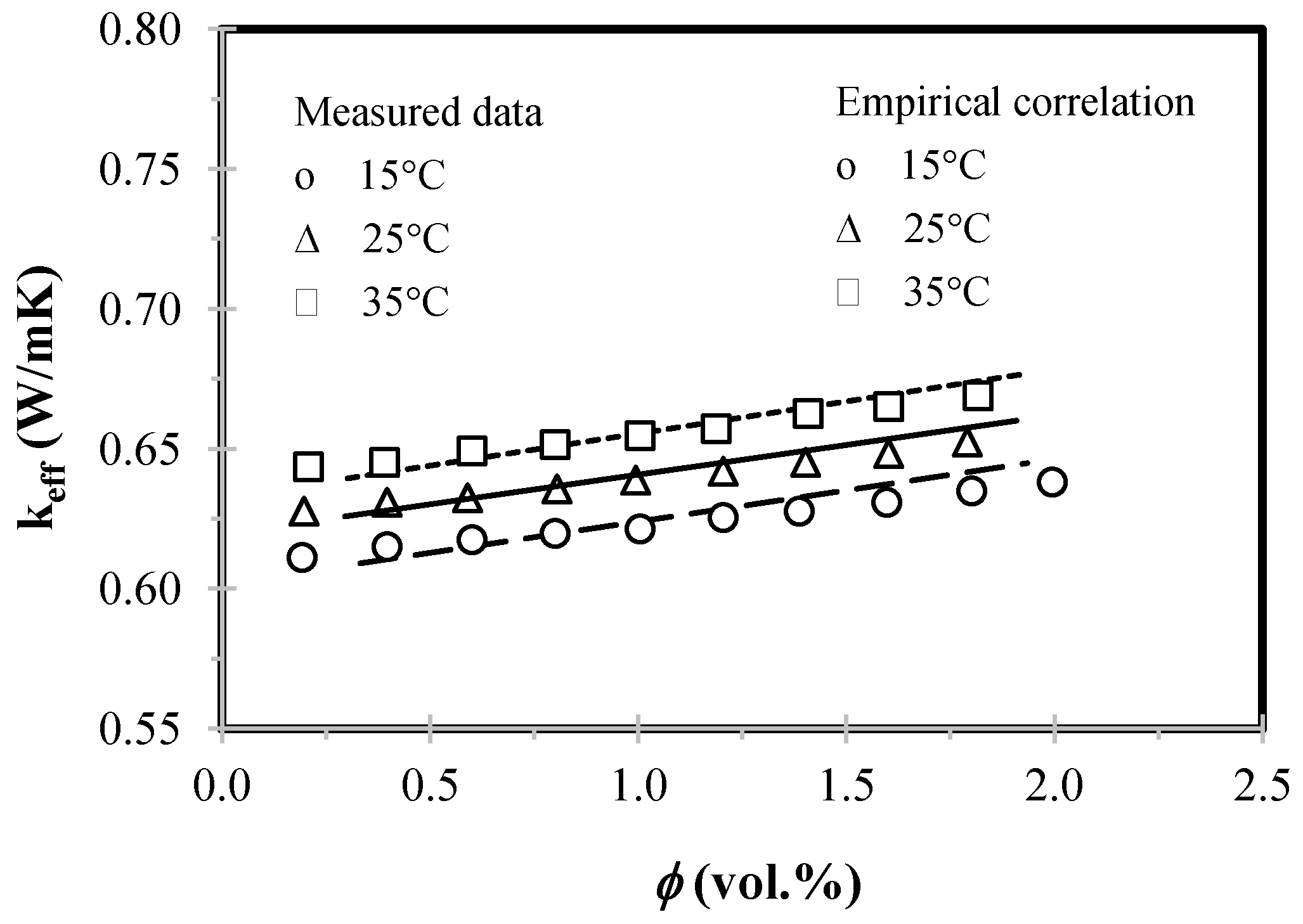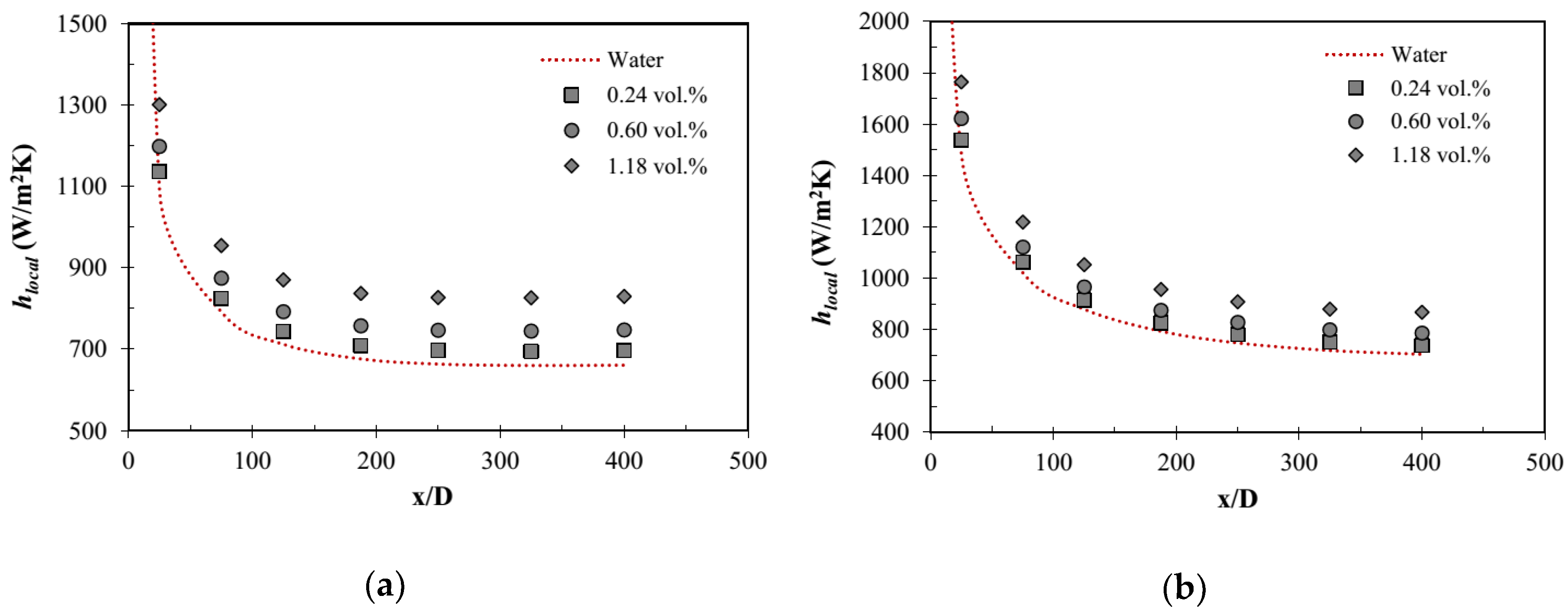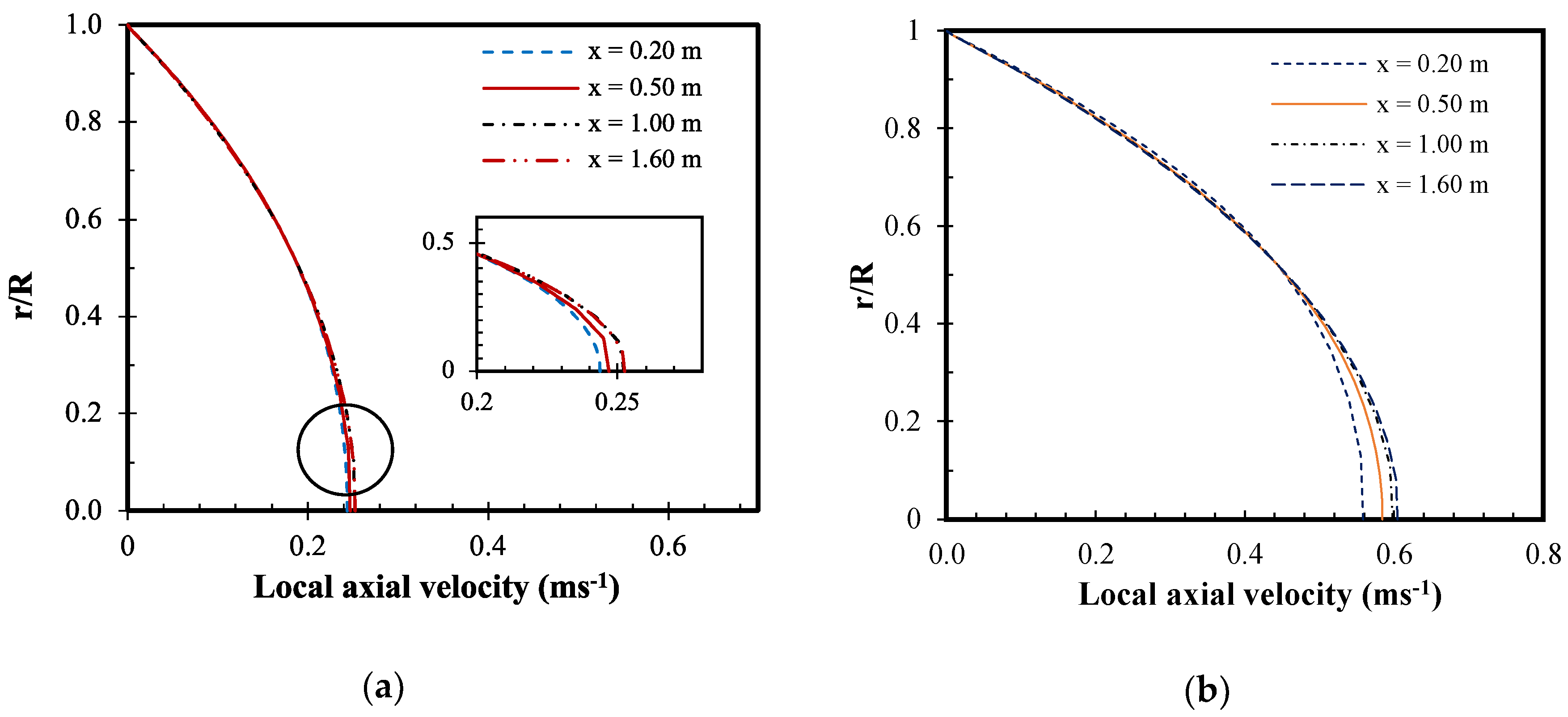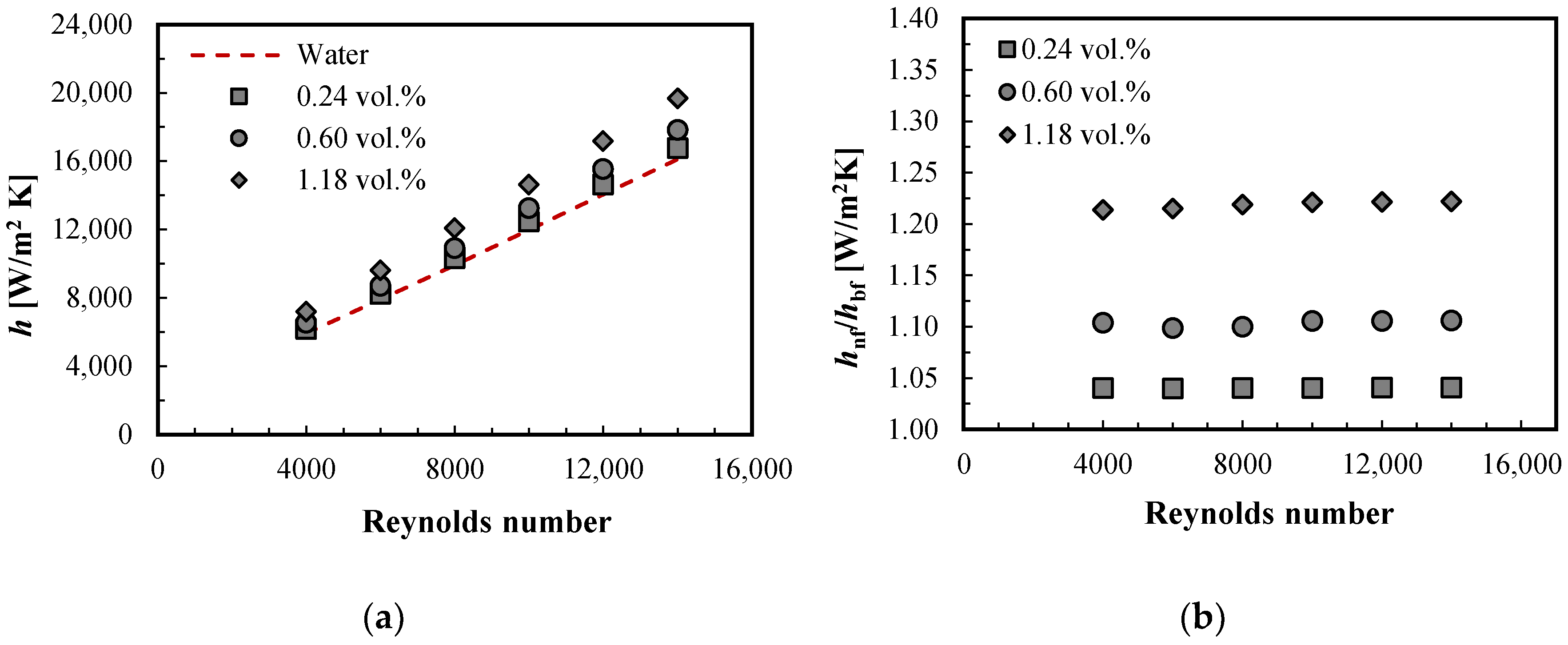Heat Transfer Enhancement of TiO2/Water Nanofluid at Laminar and Turbulent Flows: A Numerical Approach for Evaluating the Effect of Nanoparticle Loadings
Abstract
:1. Introduction
2. Numerical Model of Nanofluids
2.1. Thermophysical Properties
2.2. Grid Optimization
2.3. Two-Phase Mixture Model
2.4. Conservation Equations
2.5. Boundary Conditions
2.6. Numerical Procedure
3. Results and Discussion
3.1. Validation of Numerical Results
3.2. Laminar Model Flow for Application of Nanofluids
3.2.1. Local Convective Heat Transfer Coefficient
3.2.2. Axial Velocity in Radial Direction
3.2.3. Temperature Contours of Nanofluids
3.3. Turbulent Model Flow for Application of Nanofluids
4. Conclusions
Author Contributions
Acknowledgments
Conflicts of Interest
Nomenclature
| Cp | Specific heat [J/kg·K] | Greek symbols | |
| C1, C2, Cμ | Turbulent constant | ϕ | Volume fraction [%] |
| D | Diameter [m] | μ | Dynamic viscosity [kg/m s] |
| E | Energy | ρ | Density [kg/m3] |
| f | Friction factor | Velocity vector [m/s] | |
| Gk | Heat rate production of kinetic energy [kg/m s3] | ε | Turbulent dissipation rate [m2/s3] |
| h | Heat transfer coefficient [W/m K] | ||
| k | Thermal conductivity [W/m K] | ||
| keff | Effective thermal conductivity [W/m K] | ||
| L | Length [m] | Subscripts | |
| m | Volumetric flow rate [kg/s] | ave | Average |
| n | Number of phase | bf | Base fluid |
| Nu | Nusselt number | k | Turbulent kinetic energy |
| P | Pressure [Pa] | m | Mixture |
| Pr | Prandtl number | np | Nanoparticle |
| q” | Heat flux [W/m2] | nf | Nanofluid |
| Re | Reynolds number | w | Wall |
| SE | Volumetric heat | ||
| r | Pipe radius [m] | ||
| T | Temperature [K] | ||
References
- Honda, H.; Wijayanta, A.T.; Takata, N. Condensation of R407C in a horizontal microfin tube. Int. J. Refrig. 2005, 28, 203–211. [Google Scholar] [CrossRef]
- Wijayanta, A.T.; Istanto, T.; Kariya, K.; Miyara, A. Heat transfer enhancement of internal flow by inserting punched delta winglet vortex generators with various attack angles. Exp. Therm. Fluid Sci. 2017, 87, 141–148. [Google Scholar] [CrossRef]
- Colangelo, G.; Favale, E.; Milanese, M.; de Risi, A.; Laforgia, D. Cooling of electronic devices: Nanofluids contribution. Appl. Therm. Eng. 2017, 127, 421–435. [Google Scholar] [CrossRef]
- Potenza, M.; Milanese, M.; Colangelo, G.; de Risi, A. Experimental investigation of transparent parabolic trough collector based on gas-phase nanofluid. Appl. Energy 2017, 203, 560–570. [Google Scholar] [CrossRef]
- Visconti, P.; Primiceri, P.; Costantini, P.; Colangelo, G.; Cavalera, G. Measurement and control system for thermosolar plant and performance comparison between traditional and nanofluid solar thermal collectors. Int. J. Smart Sens. Intell. Syst. 2016, 9, 681–708. [Google Scholar] [CrossRef]
- Maïga, S.E.B.; Nguyen, C.T.; Galanis, N.; Roy, G. Hydrodynamic and thermal behaviours of a nanofluid in a uniformly heated tube. In Heat Transfer VIII; Sundén, B., Brebbia, C.A., Mendes, A., Eds.; WIT Press: Ashurst, UK, 2004; Volume 46, pp. 453–462. [Google Scholar]
- Xuan, Y.; Li, Q. Heat transfer enhancement of nanofluids. Int. J. Heat Fluid Flow 2000, 21, 58–64. [Google Scholar] [CrossRef]
- Kalteh, M.; Abbassi, A.; Saffar-Avval, M.; Harting, J. Eulerian–Eulerian two-phase numerical simulation of nanofluid laminar forced convection in a microchannel. Int. J. Heat Fluid Flow 2011, 32, 107–116. [Google Scholar] [CrossRef]
- Moghari, R.M.; Akbarinia, A.; Shariat, M.; Talebi, F.; Laur, R. Two phase mixed convection Al2O3–water nanofluid flow in an annulus. Int. J. Multiph. Flow 2011, 37, 585–595. [Google Scholar] [CrossRef]
- Iacobazzi, F.; Milanese, M.; Colangelo, G.; Lomascolo, M.; de Risi, A. An explanation of the Al2O3 nanofluid thermal conductivity based on the phonon theory of liquid. Energy 2016, 116, 786–794. [Google Scholar] [CrossRef]
- Milanese, M.; Iacobazzi, F.; Colangelo, G.; de Risi, A. An investigation of layering phenomenon at the liquid–solid interface in Cu and CuO based nanofluids. Int. J. Heat Mass Transf. 2016, 103, 564–571. [Google Scholar] [CrossRef]
- Hejazian, M.; Moraveji, M.K.; Beheshti, A. Comparative Numerical Investigation on TiO2/Water Nanofluid Turbulent Flow by Implementation of Single Phase and Two Phase Approaches. Numer. Heat Transf. Part A Appl. 2014, 66, 330–348. [Google Scholar] [CrossRef]
- Vanaki, S.M.; Ganesan, P.; Mohammed, H.A. Numerical study of convective heat transfer of nanofluids: A review. Renew. Sust. Energy Rev. 2016, 54, 1212–1239. [Google Scholar] [CrossRef]
- Das, S.K.; Choi, S.U.S.; Pradeep, T.; Yu, W. Nanofluids: Science and Technology; Wiley-Interscience: Hoboken, NJ, USA, 2007. [Google Scholar]
- Behzadmehr, A.; Saffar-Avval, M.; Galanis, N. Prediction of turbulent forced convection of a nanofluid in a tube with uniform heat flux using a two phase approach. Int. J. Heat Fluid Flow 2007, 28, 211–219. [Google Scholar] [CrossRef]
- Mirmasoumi, S.; Behzadmehr, A. Numerical study of laminar mixed convection of a nanofluid in a horizontal tube using two-phase mixture model. Appl. Therm. Eng. 2008, 28, 717–727. [Google Scholar] [CrossRef]
- Namburu, P.K.; Das, D.K.; Tanguturi, K.M.; Vajjha, R.S. Numerical study of turbulent flow and heat transfer characteristics of nanofluids considering variable properties. Int. Therm. Sci. 2009, 48, 290–302. [Google Scholar] [CrossRef]
- Lotfi, R.; Saboohi, Y.; Rashidi, A.M. Numerical study of forced convective heat transfer of Nanofluids: Comparison of different approaches. Int. Commun. Heat Mass Transf. 2010, 27, 74–78. [Google Scholar] [CrossRef]
- He, Y.; Jin, Y.; Chen, H.; Ding, Y.; Cang, D.; Lu, H. Heat transfer and flow behaviour of aqueous suspensions of TiO2 nanoparticles (nanofluids) flowing upward through a vertical pipe. Int. J. Heat Mass Transf. 2007, 50, 2272–2281. [Google Scholar] [CrossRef]
- He, Y.; Men, Y.; Zhao, Y.; Lu, H.; Ding, Y. Numerical investigation into the convective heat transfer of TiO2 nanofluids flowing through a straight tube under the laminar flow conditions. App. Therm. Eng. 2009, 29, 1965–1972. [Google Scholar] [CrossRef]
- Kristiawan, B.; Kamal, S.; Suhanan; Yanuar. Thermo-hydraulic characteristics of anatase titania nanofluids flowing through a circular conduit. J. Nanosci. Nanotechnol. 2016, 16, 6078–6085. [Google Scholar] [CrossRef] [PubMed]
- Corcione, M. Heat transfer features of buoyancy-driven nanofluids inside rectangular enclosures differentially heated at the sidewalls. Int. J. Therm. Sci. 2010, 49, 1536–1546. [Google Scholar] [CrossRef]
- Fluent, A.F. Ansys Fluent Theory Guide; ANSYS, Inc.: Lebanon, NH, USA, 2010. [Google Scholar]
- Kristiawan, B.; Santoso, B.; Juwana, W.E.; Ramadhan, R.M.; Riandana, I. Numerical investigation of laminar convective heat transfer for TiO2/water nanofluids using two-phase mixture model (Eulerian approach). In Proceedings of the International Conference on Engineering, Science and Nanotechnology 2016 (ICESNANO 2016), Solo, Indonesia, 3–5 August 2016; AIP Publisher: Melville, NY, USA, 2016; Volume 1788. [Google Scholar]
- Shah, R.K. Thermal entry length solutions for the circular tube and parallel plates. In Proceedings of the Third National Heat Mass Transfer Conference, Indian Institute of Technology, Bombay, India, 27 December 1975; pp. 11–75. [Google Scholar]
- Çengel, Y.A. Heat Transfer: A Practical Approach, 2nd ed.; McGraw-Hill: New York, NY, USA, 2003. [Google Scholar]
- Kristiawan, B.; Kamal, S.; Suhanan; Yanuar. Convective heat transfer of titanium (IV) oxide nanofluids under turbulent flow condition. ARPN J. Eng. Appl. Sci. 2015, 10, 4385–4395. [Google Scholar]
- Pinto, R.V.; Fiorelli, F.A.S. Review of the mechanisms responsible for heat transfer enhancement using nanofluids. Appl. Therm. Eng. 2016, 108, 720–739. [Google Scholar] [CrossRef]










| Parameter | Value | Unit |
|---|---|---|
| Length, L | 2.0 | m |
| Inner diameter, Di | 5.0 | mm |
| Number of cells, Nx × Ny | 15 × 800 | - |
| Bias factor | 60 (axial direction) | - |
| 6 (radial direction) | ||
| Nanoparticle (nominal diameter) | TiO2 (21 nm) | - |
| Thermal conductivity of nanoparticle, knp | 13.7 | W m−1 K−1 |
| Nanoparticle density, | 4170 | kg m−3 |
| Nanoparticle volume fraction, φ | 0.24/0.60/1.18 | Vol.% |
| Density of nanofluid | See Equation (1) | kg m−3 |
| Heat specific of nanofluid | See Equation (2) | J kg−1 K−1 |
| Viscosity of nanofluids, µnf | See Equation (3) | Pa s |
| Effective thermal conductivity, keff | See Equation (4) | W m−1 K−1 |
| Heat flux, q” | 4000 | W m−2 |
| Reynolds number | - | - |
| Laminar flow | 500, 1200 | - |
| Turbulent flow | 4000–14,000 | - |
© 2018 by the authors. Licensee MDPI, Basel, Switzerland. This article is an open access article distributed under the terms and conditions of the Creative Commons Attribution (CC BY) license (http://creativecommons.org/licenses/by/4.0/).
Share and Cite
Kristiawan, B.; Santoso, B.; Wijayanta, A.T.; Aziz, M.; Miyazaki, T. Heat Transfer Enhancement of TiO2/Water Nanofluid at Laminar and Turbulent Flows: A Numerical Approach for Evaluating the Effect of Nanoparticle Loadings. Energies 2018, 11, 1584. https://doi.org/10.3390/en11061584
Kristiawan B, Santoso B, Wijayanta AT, Aziz M, Miyazaki T. Heat Transfer Enhancement of TiO2/Water Nanofluid at Laminar and Turbulent Flows: A Numerical Approach for Evaluating the Effect of Nanoparticle Loadings. Energies. 2018; 11(6):1584. https://doi.org/10.3390/en11061584
Chicago/Turabian StyleKristiawan, Budi, Budi Santoso, Agung Tri Wijayanta, Muhammad Aziz, and Takahiko Miyazaki. 2018. "Heat Transfer Enhancement of TiO2/Water Nanofluid at Laminar and Turbulent Flows: A Numerical Approach for Evaluating the Effect of Nanoparticle Loadings" Energies 11, no. 6: 1584. https://doi.org/10.3390/en11061584
APA StyleKristiawan, B., Santoso, B., Wijayanta, A. T., Aziz, M., & Miyazaki, T. (2018). Heat Transfer Enhancement of TiO2/Water Nanofluid at Laminar and Turbulent Flows: A Numerical Approach for Evaluating the Effect of Nanoparticle Loadings. Energies, 11(6), 1584. https://doi.org/10.3390/en11061584








